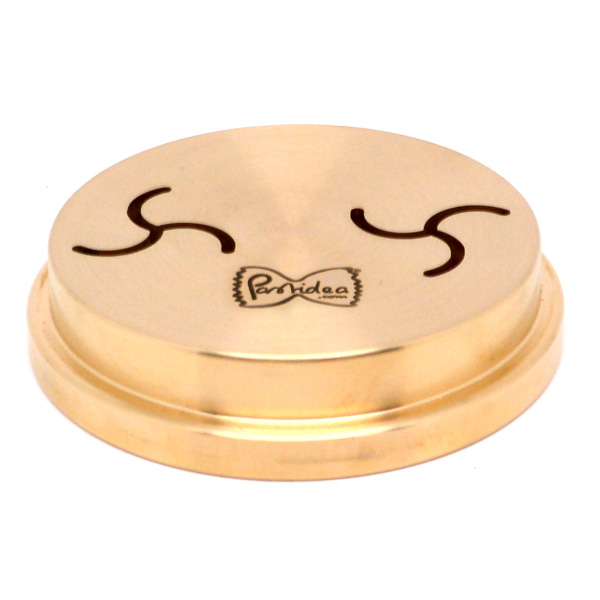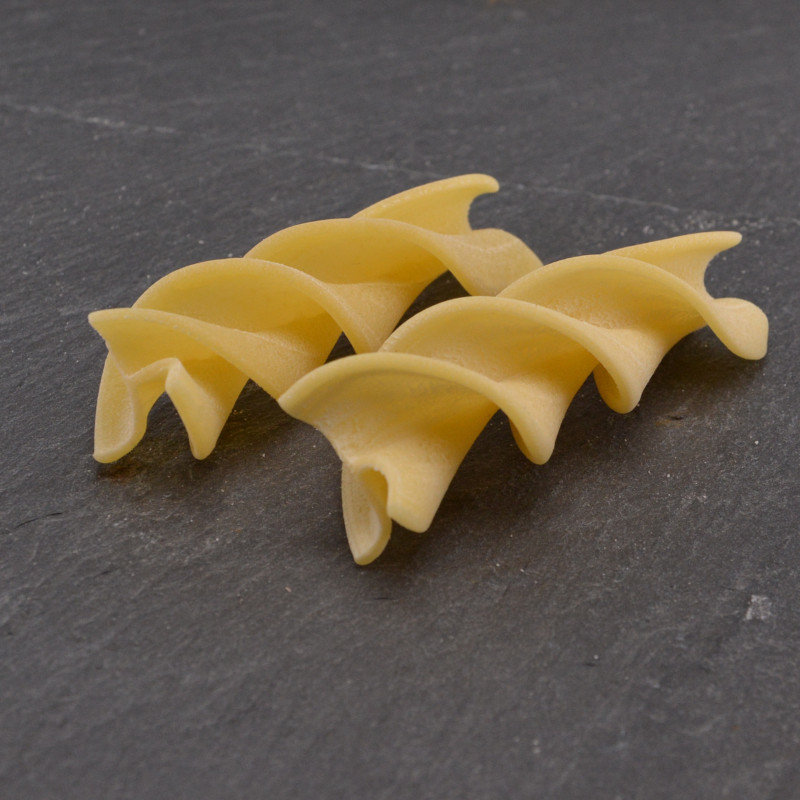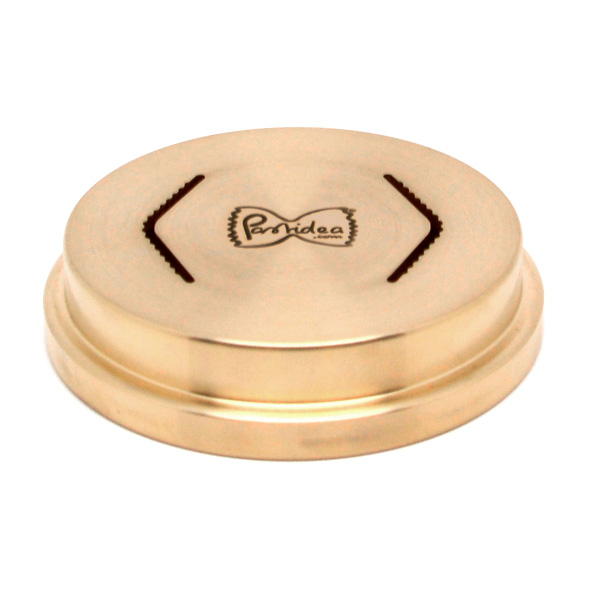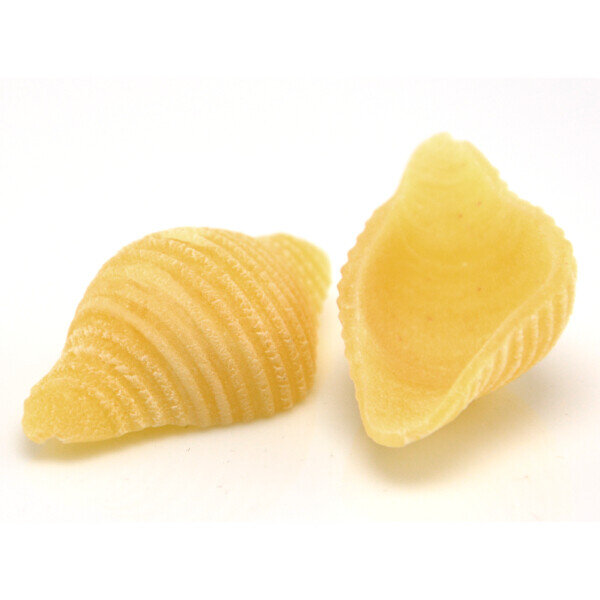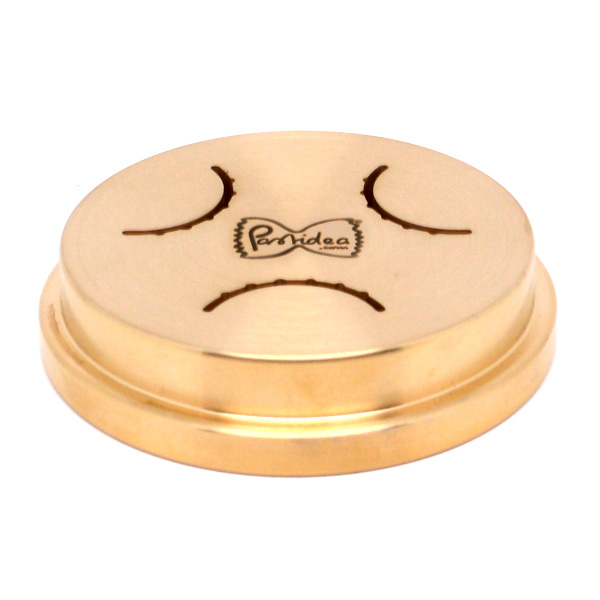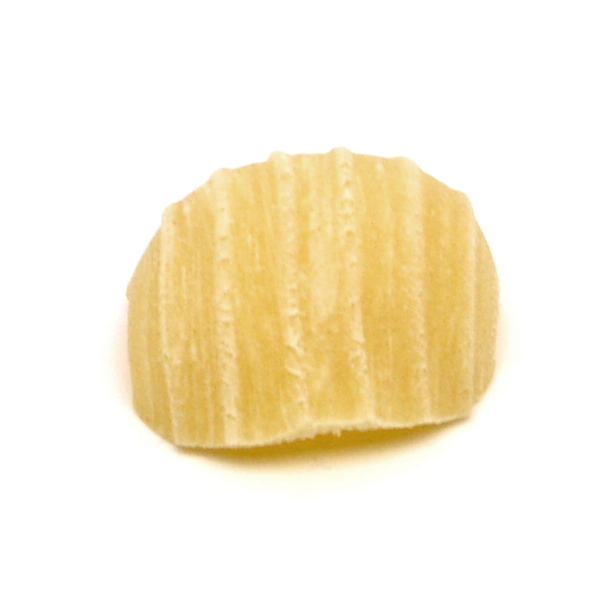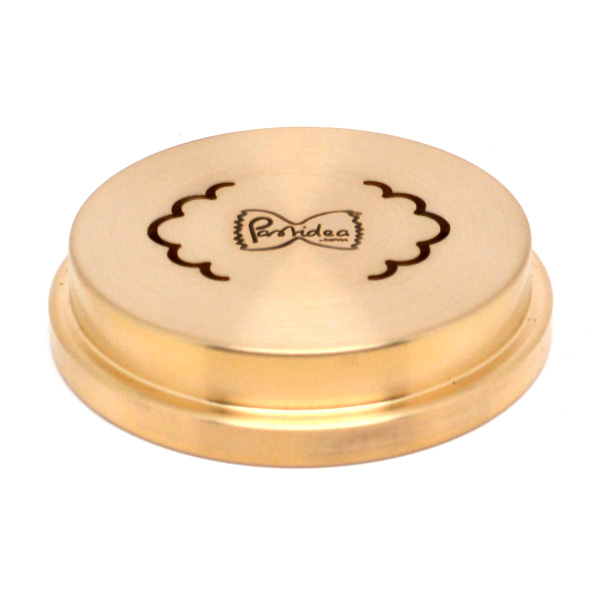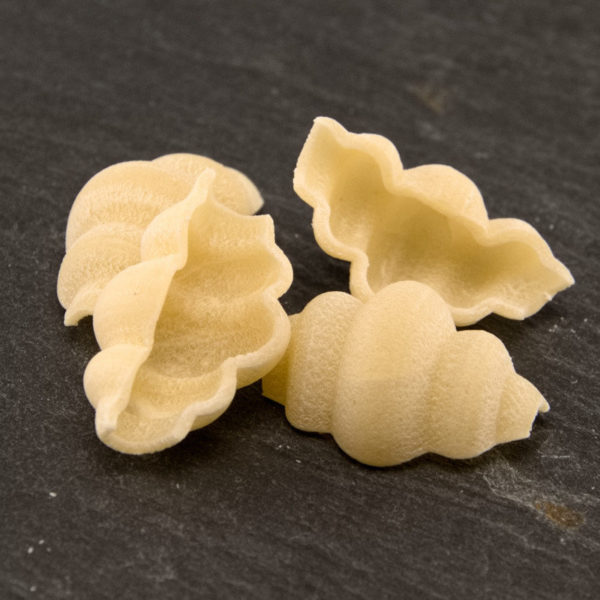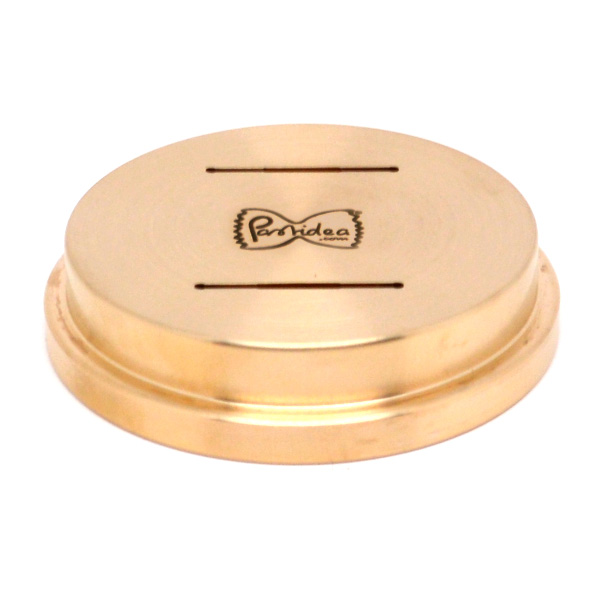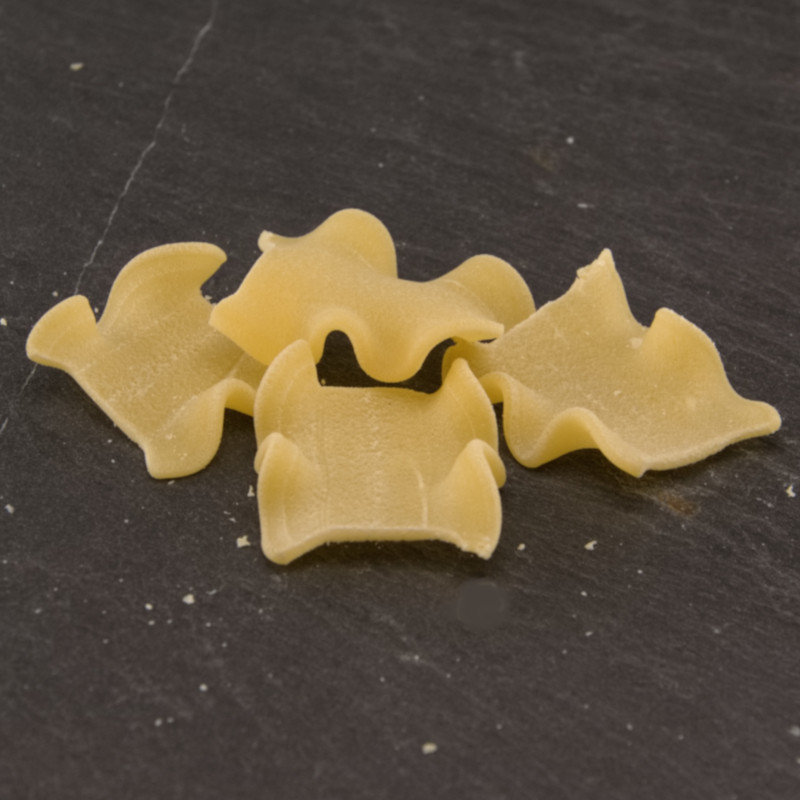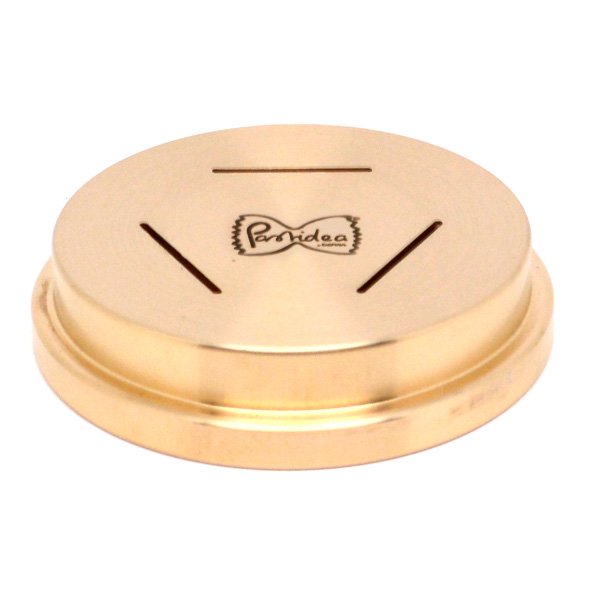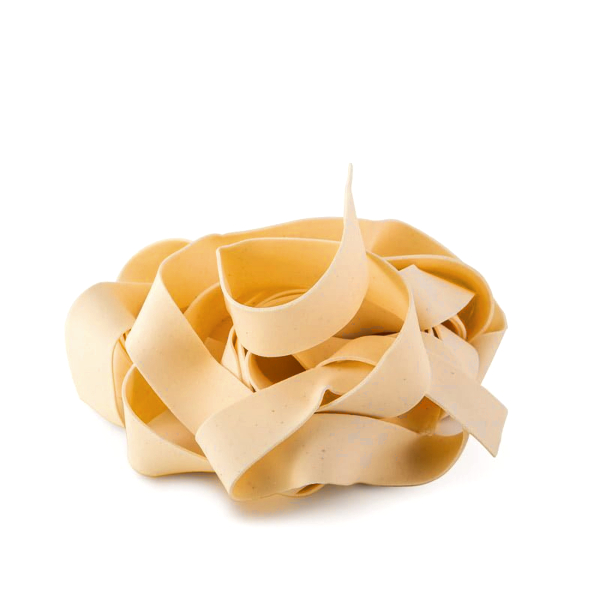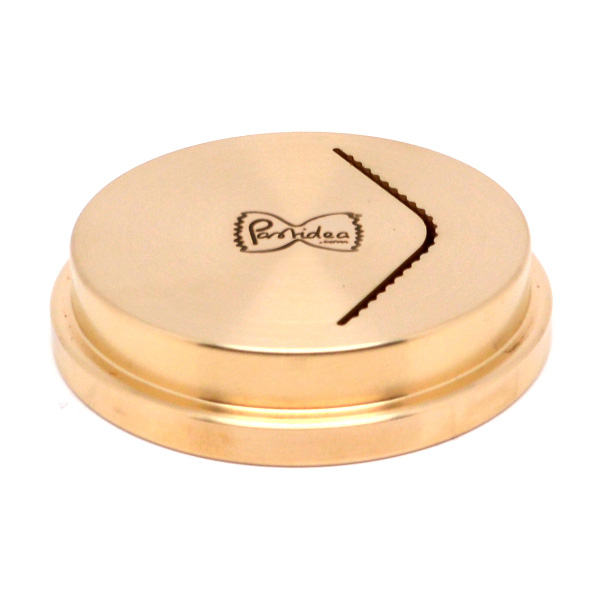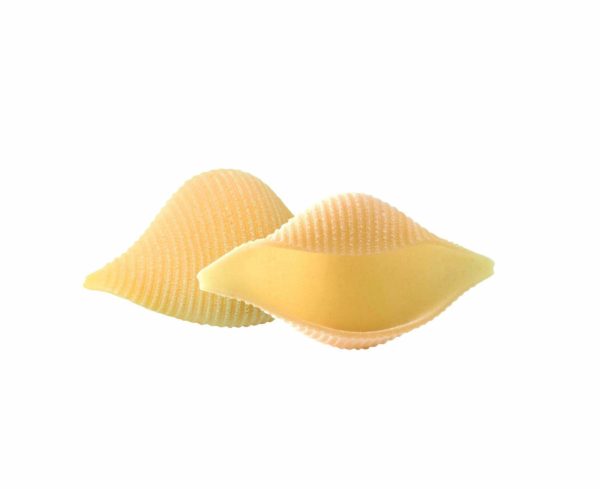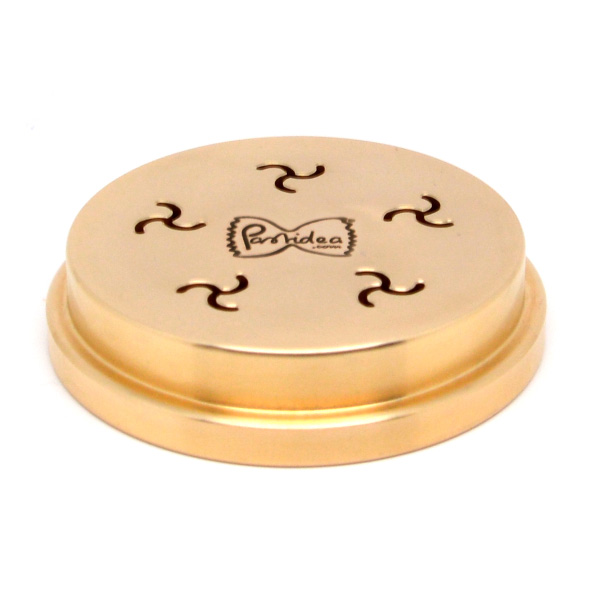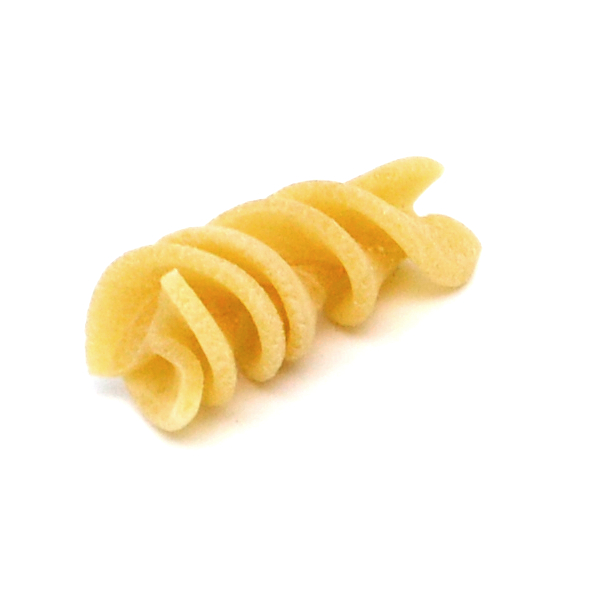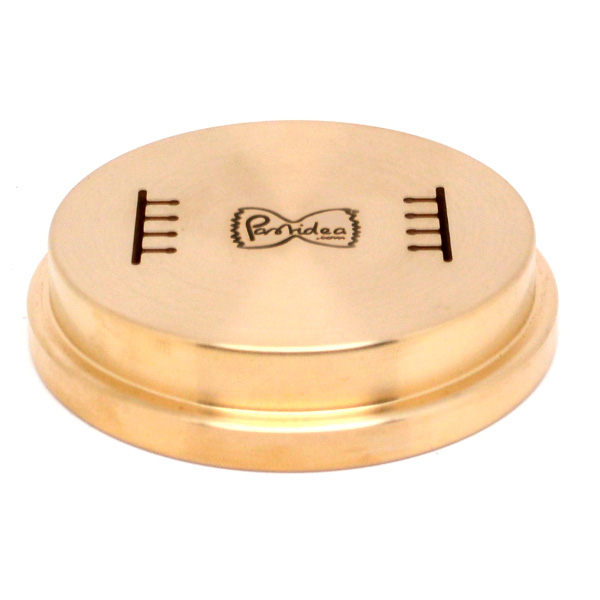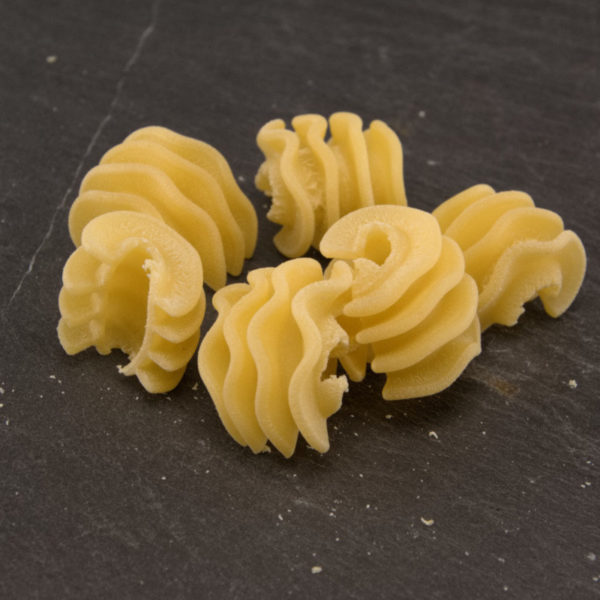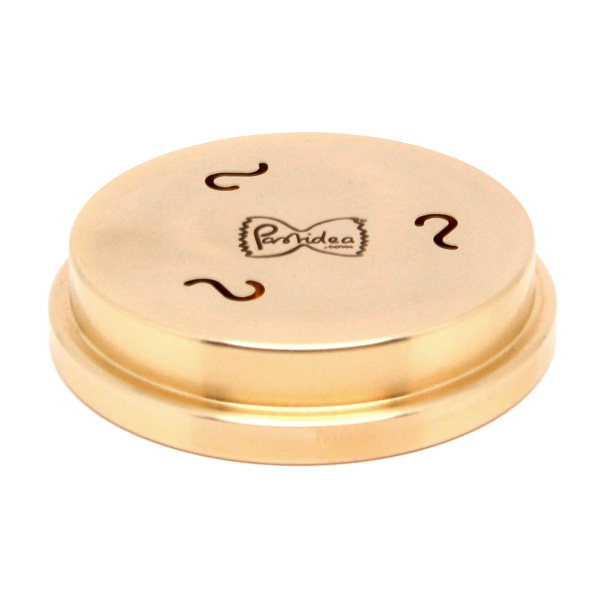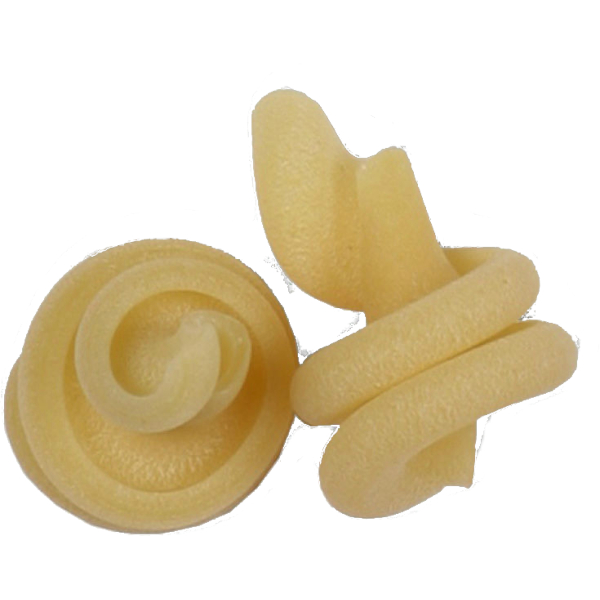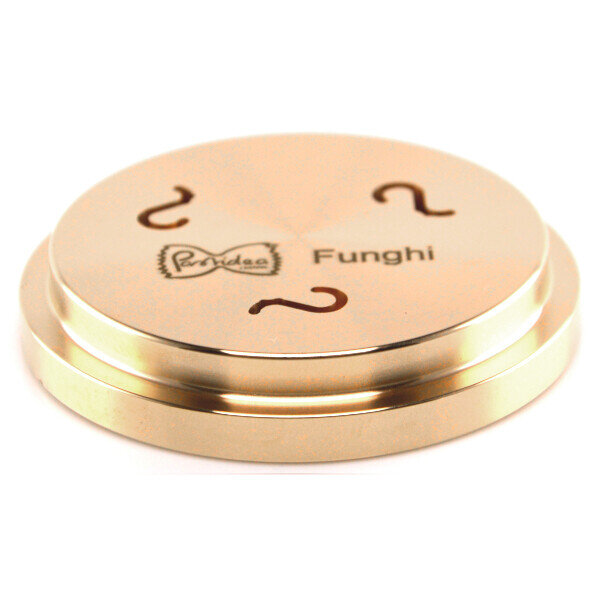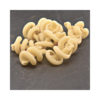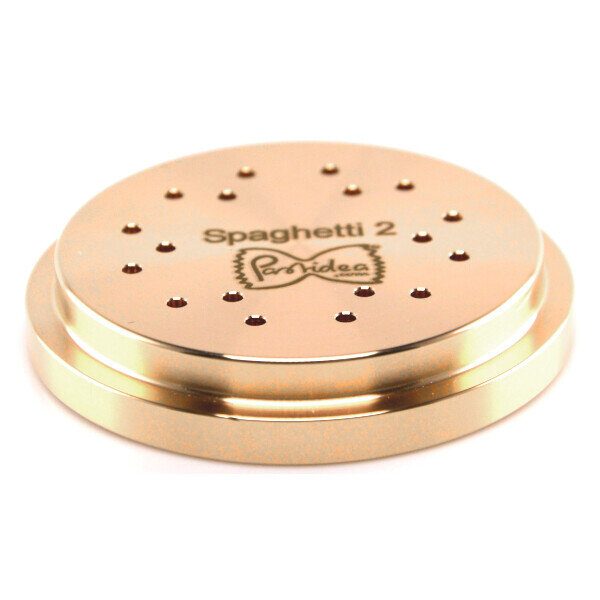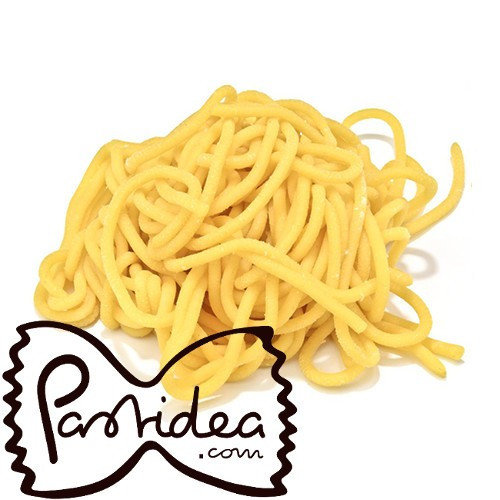Original price was: €83,9052,40 €Current price is: €52,40. incl. VAT plus shipping costs
VAT included
excl. Shipping Rate
Bronze die Fusilli A3 22 mm One of the most famous noodles in Germany is fusilli. They are often called Spirelli, Rotini and rarely Eliche. The word fusilli comes from the Italian word “fuso”, which means spindle. In manual fusilli production, spaghetti is still wrapped around a spindle. According to legend, fusilli were invented at the court in Florence around 1550. The cook's son sat under the kitchen table and played with fallen pasta scraps that he wrapped around a knitting needle. These were the first fusillis. Not quite as clear, but much more likely, is the story that the Fusillis originated in southern Italy. At some point, spaghetti began to be rolled up in a spiral for drying, as this rotation made it much easier to dry and store. What is undisputed is that the twists mean that the sauce combines particularly well with the pasta. Fusillis are easy to dry. Fusillis are available with 2, 3 or 5 wings. You can see how many propeller blades the Fusilli has by the die shape and also the die name. Ie a Fusilli A2 has two wings, an A3 has 3 wings, an A5 has 5 wings. Size: 22 mm Thickness: 1,4 mm Diameter die: 63,5 mm Pasta insert for the following professional pasta machines: La Fattorina VIP2 La Fattorina VIP4 Fimar MPF 2.5 Fimar MPF 4 Fimar PF25E Fimar PF40E Fimar NMF8 No adapter or similar is required . The die fits directly into the above-mentioned pasta machines. Why bronze: Bronze dies were the traditional way of making pasta. The pasta made “al bronzo” can only be found rarely and usually only in selected delicatessens. By pressing the pasta dough through the bronze matrices, the surface of the pasta is slightly roughened at the same time, making the pasta easier to grip. This allows the pasta to better absorb the sauce, flavors and spices later on. Would you like to learn more about bronze matrices? Then we recommend this article to you here. Recipe: It is recommended to use durum wheat semolina, enough cold liquid such as water and/or egg. The dough should be kneaded for about 8-10 minutes, this is the only way the gluten from the durum wheat can fully develop. The result should be a moist, crumbly dough. You can find a standard recipe for our matrices here. The matrices can also be used to produce gluten-free pasta. Storage: Do you have several bronze matrices and are looking for storage to protect the matrix from dust and darkening caused by light? Then we recommend our storage systems to you here .
Original price was: €83,9052,40 €Current price is: €52,40. incl. VAT plus shipping costs
VAT included
excl. Shipping Rate
Bronze die Conchiglia Rigata 28 mm “Conchiglia” is the Italian word for “shell”. The conchiglia is related to the conchigliette, the “small mussel”, which is also available as a matrix. In the “gigante” version, i.e. gigantic in size, the maximum has been achieved from the bronze matrix, so that it is also suitable for filling. The “rigata” means that this shell has grooves. Thanks to the grooves and the very finely roughened effect, which can only be achieved with bronze matrices, this mussel can absorb the sauce particularly well. Size: 28 mm Thickness: 1,2 mm Diameter die: 63,5 mm Pasta insert for the following professional pasta machines: La Fattorina VIP2 La Fattorina VIP4 Fimar MPF 2.5 Fimar MPF 4 Fimar PF25E Fimar PF40E Fimar NMF8 No adapter or similar is required . The die fits directly into the above-mentioned pasta machines. Why bronze: Bronze dies were the traditional way of making pasta. The pasta made “al bronzo” can only be found rarely and usually only in selected delicatessens. By pressing the pasta dough through the bronze matrices, the surface of the pasta is slightly roughened at the same time, making the pasta easier to grip. This allows the pasta to better absorb the sauce, flavors and spices later on. Would you like to learn more about bronze matrices? Then we recommend this article to you here. Recipe: It is recommended to use durum wheat semolina, enough cold liquid such as water and/or egg. The dough should be kneaded for about 8-10 minutes, this is the only way the gluten from the durum wheat can fully develop. The result should be a moist, crumbly dough. You can find a standard recipe for our matrices here. The matrices can also be used to produce gluten-free pasta. Storage: Do you have several bronze matrices and are looking for storage to protect the matrix from dust and darkening caused by light? Then we recommend our storage systems to you here .
Original price was: €83,9052,40 €Current price is: €52,40. incl. VAT plus shipping costs
VAT included
excl. Shipping Rate
Bronze die Orecchiette Rigate Orecchiette means something like “little ears” in German. They originally come from the Apulia region with the capital Bari. Traditionally they are made by hand, using a large wooden board, a knife and your fingers. You form a thin roll out of a piece of dough and cut off individual portions, then pull and push them forward at the same time with the handle of a kitchen knife and turn them into small mini ears. In our version, the orecchiette are formed by machine, the shape is slightly different than the hand version, but it is much faster and more relaxed. The sauce can collect easily in the shell shape of the noodle. Size: 21 mm Thickness: 1,1 mm Diameter die: 63,5 mm Pasta insert for the following professional pasta machines: La Fattorina VIP2 La Fattorina VIP4 Fimar MPF 2.5 Fimar MPF 4 Fimar PF25E Fimar PF40E Fimar NMF8 No adapter or similar is required . The die fits directly into the above-mentioned pasta machines. Why bronze: Bronze dies were the traditional way of making pasta. The pasta made “al bronzo” can only be found rarely and usually only in selected delicatessens. By pressing the pasta dough through the bronze matrices, the surface of the pasta is slightly roughened at the same time, making the pasta easier to grip. This allows the pasta to better absorb the sauce, flavors and spices later on. Would you like to learn more about bronze matrices? Then we recommend this article to you here. Recipe: It is recommended to use durum wheat semolina, enough cold liquid such as water and/or egg. The dough should be kneaded for about 8-10 minutes, this is the only way the gluten from the durum wheat can fully develop. The result should be a moist, crumbly dough. You can find a standard recipe for our matrices here. The matrices can also be used to produce gluten-free pasta. Storage: Do you have several bronze matrices and are looking for storage to protect the matrix from dust and darkening caused by light? Then we recommend our storage systems to you here .
Original price was: €83,9052,40 €Current price is: €52,40. incl. VAT plus shipping costs
VAT included
excl. Shipping Rate
Bronze Gnocco Napoletano die This pasta use for pasta production is gnocchi/nocken/nockerl from the Campania region with the capital Naples. The shape was inspired by classic potato gnocchi. The Gnoccho Napoletano is the small version (there are two larger versions), which is a real all-rounder: whether it's a pasta salad, a side dish or a main course with sauce... This pasta almost always works. This format is also easy to dry. Size: 25,5 mm Thickness: 1,2 mm Diameter die: 63,5 mm Pasta insert for the following professional pasta machines: La Fattorina VIP2 La Fattorina VIP4 Fimar MPF 2.5 Fimar MPF 4 Fimar PF25E Fimar PF40E Fimar NMF8 No adapter or similar is required . needed. The die fits directly into the above-mentioned pasta machines. Why bronze: Bronze dies were the traditional way of making pasta. The pasta made “al bronzo” can only be found rarely and usually only in selected delicatessens. By pressing the pasta dough through the bronze matrices, the surface of the pasta is slightly roughened at the same time, making the pasta easier to grip. This allows the pasta to better absorb the sauce, flavors and spices later on. Would you like to learn more about bronze matrices? Then we recommend this article to you here. Recipe: It is recommended to use durum wheat semolina, enough cold liquid such as water and/or egg. The dough should be kneaded for about 8-10 minutes, this is the only way the gluten from the durum wheat can fully develop. The result should be a moist, crumbly dough. You can find a standard recipe for our matrices here. The matrices can also be used to produce gluten-free pasta. Storage: Do you have several bronze matrices and are looking for storage to protect the matrix from dust and darkening caused by light? Then we recommend our storage systems to you here .
Original price was: €83,9052,40 €Current price is: €52,40. incl. VAT plus shipping costs
VAT included
excl. Shipping Rate
Mafalde / Manfredini bronze die Tip: Mafalde and Reginette are very similar pastas. They both have a wavy edge that catches the sauce particularly well. The difference is in the width. The Reginette are 1,8 cm wide, the Mafalde 2,8 cm wide. Reginette are mainly eaten long. Due to the impressive width of the Mafalde, they also cut a good figure as a side dish. While Reginette translates as “little queen”, the Manfredi or Manfredini (who are also known under the name Mafalde) owe their name to a king: They were named after Manfred of Swabia, who was King of Sicily from 1258 to 1266 had his reputation as a sweet tooth. The mafalde were traditionally served with ricotta, the wavy edge helps the ricotta to hold better. Size: 25 mm Thickness: 1,1 mm / 1,2 mm Diameter die: 63,5 mm Pasta insert for the following professional pasta machines: La Fattorina VIP2 La Fattorina VIP4 Fimar MPF 2.5 Fimar MPF 4 Fimar PF25E Fimar PF40E Fimar NMF8 No adapter is required etc. required. The die fits directly into the above-mentioned pasta machines. Why bronze: Bronze dies were the traditional way of making pasta. The pasta made “al bronzo” can only be found rarely and usually only in selected delicatessens. By pressing the pasta dough through the bronze matrices, the surface of the pasta is slightly roughened at the same time, making the pasta easier to grip. This allows the pasta to better absorb the sauce, flavors and spices later on. Would you like to learn more about bronze matrices? Then we recommend this article to you here. Recipe: It is recommended to use durum wheat semolina, enough cold liquid such as water and/or egg. The dough should be kneaded for about 8-10 minutes, this is the only way the gluten from the durum wheat can fully develop. The result should be a moist, crumbly dough. You can find a standard recipe for our matrices here. The matrices can also be used to produce gluten-free pasta. Storage: Do you have several bronze matrices and are looking for storage to protect the matrix from dust and darkening caused by light? Then we recommend our storage systems to you here .
Original price was: €83,9052,40 €Current price is: €52,40. incl. VAT plus shipping costs
VAT included
excl. Shipping Rate
Die made of bronze pappardelle 20 mm Pappardelle – isn’t that a pretty name? I suspect the name comes from the Italian verb “pappare” – colloquially it means something like “to feed”. Makes some sense too. I can never get enough of pappardelle and I devour it. Pappardelle are ultimately nothing more than tagliatelle, with the only difference being that they are much wider. While tagliatelle are usually between 6 and 8 mm wide, if they are a little over 1 cm wide they can be called pappardelle. Originally, these noodles were always prepared with eggs. But as always: Whatever you like and taste good is allowed. Size: 20 mm Thickness: 1 mm Diameter die: 63,5 mm Pasta insert for the following professional pasta machines: La Fattorina VIP2 La Fattorina VIP4 Fimar MPF 2.5 Fimar MPF 4 Fimar PF25E Fimar PF40E Fimar NMF8 No adapter or similar is required. The die fits directly into the above-mentioned pasta machines. Why bronze: Bronze dies were the traditional way of making pasta. The pasta made “al bronzo” can only be found rarely and usually only in selected delicatessens. By pressing the pasta dough through the bronze matrices, the surface of the pasta is slightly roughened at the same time, making the pasta easier to grip. This allows the pasta to better absorb the sauce, flavors and spices later on. Would you like to learn more about bronze matrices? Then we recommend this article to you here. Recipe: It is recommended to use durum wheat semolina, enough cold liquid such as water and/or egg. The dough should be kneaded for about 8-10 minutes, this is the only way the gluten from the durum wheat can fully develop. The result should be a moist, crumbly dough. You can find a standard recipe for our matrices here. The matrices can also be used to produce gluten-free pasta. Storage: Do you have several bronze matrices and are looking for storage to protect the matrix from dust and darkening caused by light? Then we recommend our storage systems to you here .
Bronze Conchiglione Rigato die for La Fattorina VIP2, VIP4, Fimar MPF 2.5, MPF 4, PF25E, PF40E, NMF8
Original price was: €83,9052,40 €Current price is: €52,40. incl. VAT plus shipping costs
VAT included
excl. Shipping Rate
Bronze Conchiglione Rigato die “Conchiglione” is the Italian word for “very large mussel” and the “rigato” makes it a striped mussel. The large shape is ideal for filling. You can find a suitable recipe here. Size: 47 mm Thickness: 1,1 mm Diameter die: 63 mm Pasta insert for the following professional pasta machines: La Fattorina VIP2 La Fattorina VIP4 Fimar MPF 2.5 Fimar MPF 4 Fimar PF25E Fimar PF40E Fimar NMF8 No adapter or similar is required. The die fits directly into the above-mentioned pasta machines. Why bronze: Bronze dies were the traditional way of making pasta. The pasta made “al bronzo” can only be found rarely and usually only in selected delicatessens. By pressing the pasta dough through the bronze matrices, the surface of the pasta is slightly roughened at the same time, making the pasta easier to grip. This allows the pasta to better absorb the sauce, flavors and spices later on. Would you like to learn more about bronze matrices? Then we recommend this article to you here. Recipe: It is recommended to use durum wheat semolina, enough cold liquid such as water and/or egg. The dough should be kneaded for about 8-10 minutes, this is the only way the gluten from the durum wheat can fully develop. The result should be a moist, crumbly dough. You can find a standard recipe for our matrices here. The matrices can also be used to produce gluten-free pasta. Storage: Do you have several bronze matrices and are looking for storage to protect the matrix from dust and darkening caused by light? Then we recommend our storage systems to you here .
Original price was: €83,9052,40 €Current price is: €52,40. incl. VAT plus shipping costs
VAT included
excl. Shipping Rate
Bronze die Fusilli A3 10mm One of the most famous noodles in Germany is fusilli. They are often called Spirelli, Rotini and rarely Eliche. The word fusilli comes from the Italian word “fuso”, which means spindle. In manual fusilli production, spaghetti is still wrapped around a spindle. According to legend, fusilli were invented at the court in Florence around 1550. The cook's son sat under the kitchen table and played with fallen pasta scraps that he wrapped around a knitting needle. These were the first fusillis. Not quite as clear, but much more likely, is the story that the Fusillis originated in southern Italy. At some point, spaghetti began to be rolled up in a spiral for drying, as the rotation made it much easier to dry and store. What is undisputed is that the twists mean that the sauce combines particularly well with the pasta. Fusillis are easy to dry. Fusillis are available with 2, 3 or 5 wings. You can see how many propeller blades the Fusilli has by the die shape and also the die name. Ie a Fusilli A2 has two wings, an A3 has 3 wings, an A5 has 5 wings. Size: 10 mm Thickness: 1,1 mm Diameter die: 63,5 mm Pasta insert for the following professional pasta machines: La Fattorina VIP2 La Fattorina VIP4 Fimar MPF 2.5 Fimar MPF 4 Fimar PF25E Fimar PF40E Fimar NMF8 No adapter or similar is required . The die fits directly into the above-mentioned pasta machines. Why bronze: Bronze dies were the traditional way of making pasta. The pasta made “al bronzo” can only be found rarely and usually only in selected delicatessens. By pressing the pasta dough through the bronze matrices, the surface of the pasta is slightly roughened at the same time, making the pasta easier to grip. This allows the pasta to better absorb the sauce, flavors and spices later on. Would you like to learn more about bronze matrices? Then we recommend this article to you here. Recipe: It is recommended to use durum wheat semolina, enough cold liquid such as water and/or egg. The dough should be kneaded for about 8-10 minutes, this is the only way the gluten from the durum wheat can fully develop. The result should be a moist, crumbly dough. You can find a standard recipe for our matrices here. The matrices can also be used to produce gluten-free pasta. Storage: Do you have several bronze matrices and are looking for storage to protect the matrix from dust and darkening caused by light? Then we recommend our storage systems to you here .
Original price was: €83,9052,40 €Current price is: €52,40. incl. VAT plus shipping costs
VAT included
excl. Shipping Rate
Bronze radiator die Radiatore means nothing other than radiator. Surely you know those radiators that used to not be so flat but had lots of tubes or fins? The Radiatore is one of the most popular pasta shapes. Not only are they a very uncomplicated format, they are easy to make, they absorb the sauce particularly well thanks to the many struts and they also look good. They are also easy to dry and will not break even in less than perfect drying conditions. Size: 19 mm Thickness: 1 mm Diameter die: 63,5 mm Pasta insert for the following professional pasta machines: La Fattorina VIP2 La Fattorina VIP4 Fimar MPF 2.5 Fimar MPF 4 Fimar PF25E Fimar PF40E Fimar NMF8 No adapter or similar is required. The die fits directly into the above-mentioned pasta machines. Why bronze: Bronze dies were the traditional way of making pasta. The pasta made “al bronzo” can only be found rarely and usually only in selected delicatessens. By pressing the pasta dough through the bronze matrices, the surface of the pasta is slightly roughened at the same time, making the pasta easier to grip. This allows the pasta to better absorb the sauce, flavors and spices later on. Would you like to learn more about bronze matrices? Then we recommend this article to you here. Recipe: It is recommended to use durum wheat semolina, enough cold liquid such as water and/or egg. The dough should be kneaded for about 8-10 minutes, this is the only way the gluten from the durum wheat can fully develop. The result should be a moist, crumbly dough. You can find a standard recipe for our matrices here. The matrices can also be used to produce gluten-free pasta. Storage: Do you have several bronze matrices and are looking for storage to protect the matrix from dust and darkening caused by light? Then we recommend our storage systems to you here .
Original price was: €83,9052,40 €Current price is: €52,40. incl. VAT plus shipping costs
VAT included
excl. Shipping Rate
Bronze Funghi / Trottole die 10 mm “Funghi” means nothing other than “mushrooms”. In Germany they are also known as Hütchennudeln, Schneckle or Trulli. In Italy you can also find them under the name Insalatonde (which is also the umbrella term for pasta salad pasta) and Cappelletti. Size: 10 mm Thickness: 1,1 mm Diameter die: 63 mm Pasta insert for the following professional pasta machines: La Fattorina VIP2 La Fattorina VIP4 Fimar MPF 2.5 Fimar MPF 4 Fimar PF25E Fimar PF40E Fimar NMF8 No adapter or similar is required. The die fits directly into the above-mentioned pasta machines. Why bronze: Bronze dies were the traditional way of making pasta. The pasta made “al bronzo” can only be found rarely and usually only in selected delicatessens. By pressing the pasta dough through the bronze matrices, the surface of the pasta is slightly roughened at the same time, making the pasta easier to grip. This allows the pasta to better absorb the sauce, flavors and spices later on. Would you like to learn more about bronze matrices? Then we recommend this article to you here. Recipe: It is recommended to use durum wheat semolina, enough cold liquid such as water and/or egg. The dough should be kneaded for about 8-10 minutes, this is the only way the gluten from the durum wheat can fully develop. The result should be a moist, crumbly dough. You can find a standard recipe for our matrices here. The matrices can also be used to produce gluten-free pasta. Storage: Do you have several bronze matrices and are looking for storage to protect the matrix from dust and darkening caused by light? Then we recommend our storage systems to you here .
40,90 € incl. VAT plus shipping costs
VAT included
excl. Shipping Rate
Bronze Funghi / Trottole die “Funghi” means nothing other than “mushrooms”. In Germany they are also known as Hütchennudeln, Schneckle or Trulli. In Italy you can also find them under the name Insalatonde (which is also the umbrella term for pasta salad pasta) and Cappelletti. Diameter of die: 56 mm Pasta insert for the following professional pasta machines: La Fattorina Fimar MPF 1.5 Fimar PF15E Arcobaleno AEX-10 Bartscher GGM-Gastro NMF5 No adapter or similar is required. The die fits directly into the above-mentioned pasta machines. Why bronze: Bronze dies were the traditional way of making pasta. The pasta made “al bronzo” can only be found rarely and usually only in selected delicatessens. By pressing the pasta dough through the bronze matrices, the surface of the pasta is slightly roughened at the same time, making the pasta easier to grip. This allows the pasta to better absorb the sauce, flavors and spices later on. Would you like to learn more about bronze matrices? Then we recommend this article to you here. Recipe: It is recommended to use durum wheat semolina, enough cold liquid such as water and/or egg. The dough should be kneaded for about 8-10 minutes, this is the only way the gluten from the durum wheat can fully develop. The result should be a moist, crumbly dough. You can find a standard recipe for our matrices here. The matrices can also be used to produce gluten-free pasta. Storage: Do you have several bronze matrices and are looking for storage to protect the matrix from dust and darkening caused by light? Then we recommend our storage systems to you here .
40,90 € incl. VAT plus shipping costs
VAT included
excl. Shipping Rate
Die made of bronze spaghetti 2mm The name spaghetti means something like small strings. The name probably comes from the fact that spaghetti used to be made with a “guitar”. The guitar was a wooden box with metal strings stretched tightly over it, like a real musical guitar. The pasta dough was placed over these strings and pressed against the wires with a pasta roller so that the spaghetti fell down in strips. Diameter of die: 56 mm Pasta insert for the following professional pasta machines: La Fattorina Fimar MPF 1.5 Fimar PF15E Arcobaleno AEX-10 Bartscher GGM-Gastro NMF5 No adapter or similar is required. The die fits directly into the above-mentioned pasta machines. Why bronze: Bronze dies were the traditional way of making pasta. The pasta made “al bronzo” can only be found rarely and usually only in selected delicatessens. By pressing the pasta dough through the bronze matrices, the surface of the pasta is slightly roughened at the same time, making the pasta easier to grip. This allows the pasta to better absorb the sauce, flavors and spices later on. Would you like to learn more about bronze matrices? Then we recommend this article to you here. Recipe: It is recommended to use durum wheat semolina, enough cold liquid such as water and/or egg. The dough should be kneaded for about 8-10 minutes, this is the only way the gluten from the durum wheat can fully develop. The result should be a moist, crumbly dough. You can find a standard recipe for our matrices here. The matrices can also be used to produce gluten-free pasta. Storage: Do you have several bronze matrices and are looking for storage to protect the matrix from dust and darkening caused by light? Then we recommend our storage systems to you here .


